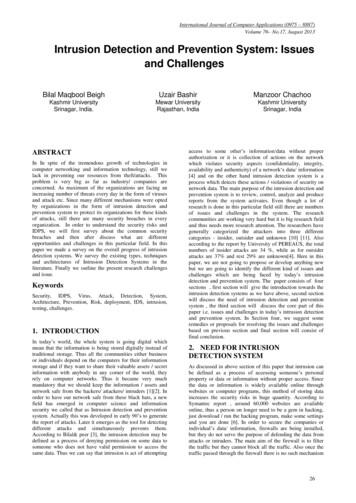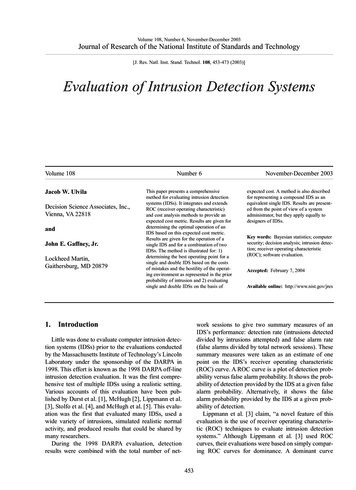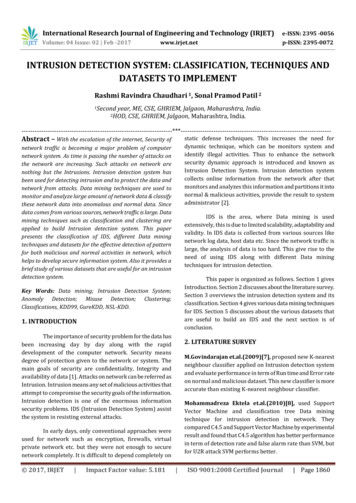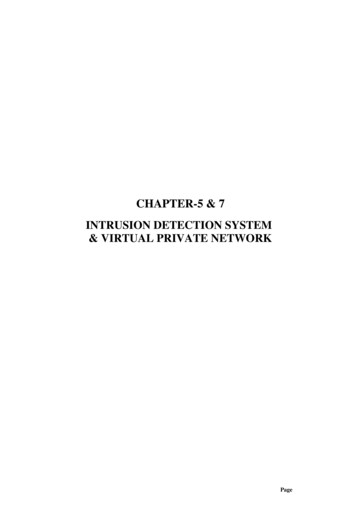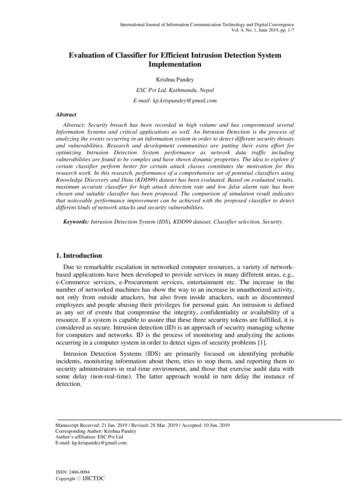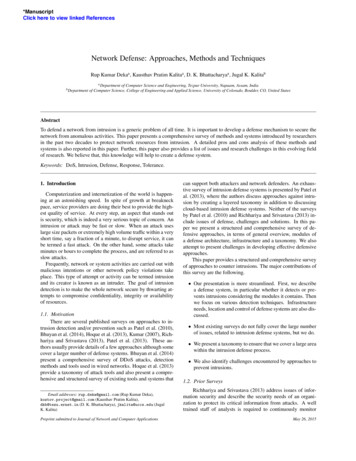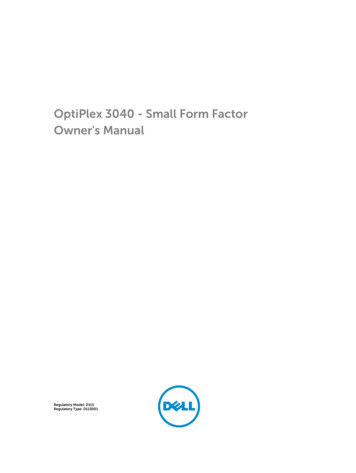
Transcription
Intrusion Detection UsingMonitor Information FusionStudent: Atul BoharaP.I.: William H. Sanders
Previous Work [1]Intrusion detection by combining and clustering diverse monitor dataSystem LogsFirewall LogsHost-level andnetwork-level contextFeature extractionand selectionCluster analysisand prioritizationIntrusion Detection in Enterprise Systems by Combining and Clustering Diverse Monitor Data. Atul Bohara, Uttam Thakore, William H. Sanders.In Proceedings of the 2016 Symposium and Bootcamp on the Science of Security (HotSoS '16)
Previous Work [2]Lateral movement detection using distributed data fusionCluster1 C4Cluster2 C6C5 C6C4 C5Host 4Target HostHost 56C2 C3C65C5Host 2 C1 C2C3 C4Host 34C43C32Entry PointHost 1C2C11Lateral Movement Detection Using Distributed Data Fusion. Ahmed Fawaz, Atul Bohara, Carmen Cheh, William H. Sanders.In Proceedings of 35th Symposium on Reliable Distributed Systems (SRDS 2016).3
Ongoing WorkProactive detection of advanced attacks through IdentifyTargetsActions onTarget Hypothesis: events observed in the system, as a result of a multi-stageattack, are correlated. By combining the evidences of different attackstages, we can increase the confidence in the detection of overall attack E.g., Fuse the evidence of C&C and lateral movement to detect and preventa possible data exfiltration attack Data-driven modelling of attack and defense (system)
Air Force Research LaboratoryChris CaiPI: Professor Roy CampbellIntegrity Service Excellence1
CRONets: Cloud-Routed Overlay Networks We aim to understand what level of performance improvement can auser expect to get from leveraging public cloud service to build overlaynetwork, as opposed from other resource providers like ISPs. Performance metrics can include throughput, latency, loss rate, etc,corresponding to particular demands of different applications. Questions to answer: Can CRONets provide similar improvements compared to the previousexperimental studies, but in a realistic-cloud-setting? How can emerging technologies simplify the overlay path selectionproblem?2
Measurement Testbed We use PlanetLab nodes as clients and Eclipse mirros as servers. We useIBM Softlayer as cloud provider to provide overlay nodes. Blue labels indicate locations of PlanetLab nodes. Red labels indicatelocations of overlay nodes.3
Contributions Our work will help large companies as well as individual usersto best leverage the available commercial cloud networkresources to meet their specific network requirement. CRONets also has the potential to provide a robust faulttolerant transmission layer to help application surviving networkfailures. Our work will help cloud provider to better design their interdatacenter transmission mechanism to be “CRONets-friendly”.4
UNIVERSITY OF ILLINOIS AT URBANA-CHAMPAIGN ENGINEERING AT ILLINOIS INFORMATION TRUST INSTITUTEAdvisor: Professor Iyer, Professor KalbarczykKEYWHAN CHUNG
UNIVERSITY OF ILLINOIS AT URBANA-CHAMPAIGN ENGINEERING AT ILLINOIS INFORMATION TRUST INSTITUTESecurity as a Signaling Game Continued work w/ Dr. Kamhoua & Dr. Kwiat at AFRL An approach on modeling the decision making process for securityunder limited observation on the environment as a signaling game,and studying the effectiveness of the optimized decisions Simulation results had shown:– That the signaling game can reason the decisions of the attacker– Worst case scenarios for the defender– Promising evaluation results compared to the common approach Further steps:– Comparison with more advanced mitigation methods or other attack models– Deployment to a real system w/ real monitors and responses
UNIVERSITY OF ILLINOIS AT URBANA-CHAMPAIGN ENGINEERING AT ILLINOIS INFORMATION TRUST INSTITUTEAttack on Computing Infrastructuresthrough Targeted Alteration of ICS A study on seeking the possibility of utilizing the relatively weaksecurity of the ICS systems to attack a well hardened computinginfrastructure that requires advanced environmental control Studied the cooling system for Blue Waters– Campus / Building / Cooling cabinet level– Interdependency between the systems Studied Blue Waters failures related to the cooling system– Three failure scenarios with possibility of the attacker replaying throughalteration in the monitoring / control system Further steps:– Formulation of the attack model– Mitigation methods (Bro IDS, etc.)
Intel VT-x on QEMULavin Devnani
PROJECT GOALS Extend QEMU (Quick Emulator) to emulate IntelVT-x instruction set Run a hypervisor guest OS in emulatedoperating system Support future security and reliability projects
Future Applications Taint analysis of VT-x Taint analysis Symbolic execution Profiling existing hypervisors Prototyping new hypervisors Extension of VMX functionality
Cloud Security Certifications:A Comparison to Improve Cloud Service Provider SecurityCarlo Di Giulio (cdigiul2@illinos.edu)Masooda Bashir (mn@illinois.edu)09/21/2016
5/22/2016Previous StepsJanuary 4The project startsGoals: Security & Privacy inCloud Environments Evaluation of cloudvendors Market trendsApril 13ACC SeminarJune 8First paper submission3 Pillars: Focus on the first Laws and Regulations and third pillar Cloud services Security and privacy Privacy and security certifications andpoliciesstandards FedRAMP, ISO270012
ContributionEvaluation of the impact and relevance ofPrivacy and Security certifications forCloud ServicesDeeper understanding of vendors’commitment in promoting informationassuranceSuggestion of improvements to currentstandards and guidelines5/22/2016
Current Status, Accomplishments5/22/2016ISO27001:2005 and 2013FedRAMP Moderate and High baseline(DoD Lev 2-4)AICPA SOC2 (TSPC 2014 and 2016)BSI Cloud Computing Compliance ControlCriteria (C5)4
Secure ContainersKonstantin Evchenko, Read Sprabery, Abhilash Raj*,Sibin Mohan, Rakesh Bobba*, Roy H. CampbellUniversity of Illinois at Urbana-Champaign*Oregon State University
Motivation Container-based products become ubiquitous in cloud infrastructure Several parties run their containerized applications in a sharedenvironment Enables cache-based side-channel attacks (e.g. Prime Probe andFlush Reload) These attacks can be used to retrieve fine-grained sensitive information(e.g. cryptographic keys) Both attacks have been effectively carried in PaaS and IaaSinfrastructures, both in a lab and real world environments2
Cauldron Framework Design3
Workflow exampleApp 1App 2App 3App 4Core 1Cache Partition 1(Shared)Organization 1 AppApp 4App 1App 3App 4Core 2Organization 2 AppOrganization 3 AppApp 1App 2App 4App 3Core 3Cache Partition 2(Protected)Organization 1 App Flushing the cache eliminates information leak By using CAT we assign smaller partition to security-sensitive apps Flushing smaller partition reduces overheadOrganization 2 AppOrganization 3 AppLLC Flush4
Improving performance with Gang SchedulingApp 1App 2App 3App 4Core 3Cache Partition 2(Protected)Organization 1 AppApp 2App 3App 4Core 4Organization 2 AppOrganization 3 App Gang-schedule apps from the same organizationReduces the number of flushesPotentially increases idlingPossible solution: soft gang scheduling If no apps from the same org are available, schedule from other orgs No flushing Might leak some information, but not enough to enable the attackLLC Flush5
Initial results6
Future Work Design a Secure Containers framework with support frommultiple layers of the stack including hardware, hypervisor,kernel, compiler and application layer. Hardware supported isolation and sandboxes Novel scheduling techniques for increased isolation andperformance Monitoring techniques to detect compromises andprotect containers from both co-tenants and host7
Getafix: Workload-aware DataManagement in LookbackProcessing SystemsPresenter: Mainak GhoshCollaborators: Le Xu, Thomas Kao, Xiaoyao Qian, Indranil Gupta
Problem Lookback Processing Systems -- Warehouse for time series data Current systems like Druid, Pinot make workload assumptions indesign replication, caching and load balancing strategies Recent segments assigned to “hot tier” -- larger replication LRU used for cache eviction Under a different workload, this causes, poor memory utilization,large network overhead Our solution, Getafix, proposes a general solution which looks atsegment popularity to define replication, caching and load balancingstrategies.
Progress Finished so far Proposed an optimal algorithm which can minimize the replication whileimproving throughput Compare different replication strategies using a simulator Implemented Getafix inside Druid Moving on Evaluate the improvements in memory usage, effect on query throughputwhile using our adaptive replication scheme Implement popularity aware caching and load balancing strategies andmeasure their effect Publish this work in a top conference.
Energy-Aware Dynamic Code Offloading inMobile Cloud ApplicationsKirill Mechitov, Atul Sandur, and Gul Agha
IMCM: Illinois Mobile Cloud Manager Code offloading: AutomaticDynamicFine-grainedParallel Supports: Hybrid cloud with multiplecloud spaces Provides: Policy-based control by cloudprovider, app developer, user2
Research topics Monitoring Real-time fine-grained monitoring of energy use, performance,security of mobile actor-based applications Real-time monitoring of actor energy use and access patterns toidentify malicious code Optimization Refined model for actor deployment and dynamic reconfiguration inhybrid mobile-cloud spaces with security-aware priority management Model-checking Use model-checking tool for creating valid and sensible initialdeployment configurations Policy-based control Composable per-site, per-actor, per-user policies3
IMCM framework Max app performance Min mobile energy consumption Min cloud cost Min network data usageApplicationTarget GoalOrg/App/UserPolicy Application Policy Access Restrictions User preferencesPolicy ManagerApplication actionsNetwork parametersUser contextApplication profilingEnergy estimatorSystemPropertiesElasticityManagerSystem MonitorOffloadingPlanTarget goalProfiled execProfiled commDecision MakerApplication ComponentDistribution4
Future work Full IMCM Framework proof-of-concept implementation Based on Salsa for Android mobile actor platform Model-checking tool for actor deployment Timed Rebeca model of mobile-cloud hybrid applications Optimization algorithm for actor deployment andreconfiguration Performance & energy goals Policy-based access restrictions Assurance of performance guarantees/SLAs5
A Digital Forensic AnalysisFrameworkImani PalmerDepartment of Computer ScienceUniversity of Illinois at Urbana-ChampaignRoy CampbellDepartment of Computer ScienceUniversity of Illinois at Urbana-Champaign
MotivationCloud is composed of a large number of components vulnerable to attacksSystems generate an enormous amount of digital evidenceIncident responders/examiners determine the cause of the intrusionAnalysis of digital evidence remains highly subjective to the forensic practitioner
The ProblemThe digital forensic investigative process is marred byits lack of knowledge, accreditation, and human bias.
Google Search HistoryChat logsEmailAnalysisPhotosInternet Activity LogsExecutable ProgramsInternet Protocols AddressFinancial Asset RecordsAddress BooksTelephone RecordsMapsMovie FilesImagesAnalysis ToolkitConfiguration Files
Analysis ToolkitThis actor took action X is supported by facts with strength and quantityObjective AnalysisProvide quantitative assessments to detect user actionsSingle-SessionSign OnABAccessResourceCredentialTheft shPasswordUsername& PasswordCAuthenticationChallengeEDUsername& PasswordFHash toServerEHashPasswordGServerChecksHashFHash ted
FrameworkIdentify ActionsExtract EventsAction 1Evidence AEvidence BEvidence CEvidence DAction 2Evidence EEvidence FEvidence GEvidence HDefineRelationshipsConstructMappingsAction 3
Continued WorkImplement FrameworkRun case study evaluationsProvide a tool for digital forensic investigators
ASSURED CLOUD COMPUTING CENTER - INFORMATION TRUST INSTITUTE – UNIVERSITY OF ILLINOIS AT URBANA-CHAMPAIGNVerification of Distributed Key-ValueStores Using Reachability LogicStephen SkeirikPI: José Meseguer
ASSURED CLOUD COMPUTING CENTER - INFORMATION TRUST INSTITUTE – UNIVERSITY OF ILLINOIS AT URBANA-CHAMPAIGNIntroduction Knowing that a distributed system design satisfies certain– Consistency– Latency– Securityrequirements before being fully built saves time and money Model checking and deductive theorem proving-basedtechniques can both be used to verify distributed systemsmeet such requirements2
ASSURED CLOUD COMPUTING CENTER - INFORMATION TRUST INSTITUTE – UNIVERSITY OF ILLINOIS AT URBANA-CHAMPAIGNProject Status We have successfully used model-checking techniques toexplore the behavior of key-value stores, e.g. Cassandra To provide even greater assurance, we plan to developand verify models of key-value stores in reachability logic Reachability logic naturally models behaviors of complex,concurrent systems with recursive behavior (as ageneralization of both Hoare and Separation logic) We have already performed simple experiments modeling andverifying mutual exclusion algorithms3
ASSURED CLOUD COMPUTING CENTER - INFORMATION TRUST INSTITUTE – UNIVERSITY OF ILLINOIS AT URBANA-CHAMPAIGNFuture Outlook Our work will proceed in two directions:– Modeling and verifying a selection of distributedkey-value stores (e.g. Cassandra and G-DUR arepotential targets)– Using the ACC case studies to improve the effectivenessof our reachability logic analysis tools for distributedsystems (esp. heuristics and techniques for handlingundecidable theories)4
Project Topic: Dynamic securitymonitor selection and data analysisfor intrusion detectionStudent: Uttam ThakoreP.I.: William H. Sanders
Previous work A Quantitative Methodology for Security MonitorDeployment A methodology for monitor deployment to meet intrusiondetection goals and minimize monitoring cost Uses quantitative metrics to capture monitor utility and cost Uses integer programming to determine optimal monitordeployment based on intrusion detection goals and costrequirements Best Paper Award at DSN 2016 Intrusion Detection in Enterprise Systems by Combiningand Clustering Diverse Monitor Data Applied unsupervised clustering to fused network- and hostlevel security logs to identify potentially malicious behaviorwithout administrator labeling Presented at HotSoS 2016
Current work: Data-driven monitorselection in enterprise clouds Using statistical correlation techniques to identify data thatwould promote earlier investigation and detection ofincidents Intuition: Data sources with high correlation to incident-specificalerts with temporal lag are likely useful for detection Prioritize monitor deployment/alert investigation based onstrength of correlation and administrator securityrequirements Plans for this year: Refine approach and evaluate on NCSA historical security data Will submit paper (potentially to DSN 2017)Contribution: Can be used to more effectively monitor cloudsfor security, reliability, and performance incidents
Planned work: Host behavior analysisacross heterogeneous logs usingunsupervised learning Extension of HotSoS 2016 work Using unsupervised learning over heterogeneous logsto classify and track behavior of hosts over time andidentify likely malicious behavior in early stages Plans for this year: Identify unsupervised learning techniques and features thatstrongly separate behavior classes in heterogeneous logs Evaluate on NCSA historical security dataContribution: Can be used to more effectively detectadvanced intrusions in clouds
IBM Softlayer as cloud provider to provide overlay nodes. Blue labels indicate locations of PlanetLab nodes. Red labels indicate locations of overlay nodes. 4 . Implement popularity aware caching and load balancing strategies and measure their effect Publish this work in a top conference. Energy-Aware Dynamic Code Offloading in

